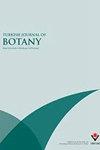海藻基液体提取物对眼藻和盐藻生物量和脂质积累的影响
IF 1.5
4区 生物学
Q3 PLANT SCIENCES
引用次数: 1
摘要
:海藻液体肥料(SLF)含有微藻生长所必需的大量营养素、微量营养素和微量营养素。本研究旨在评估SLFs在生物量生产、生化和生理过程中的效率;并在不同SLF浓度下对所选海藻(即Kappaphycus alvarezii、Gelidiella acerosa和Turbinaria ornata)进行了研究。对两种单细胞绿藻在三种不同有机介质上的生长性能的比较分析表明,红海藻液体肥料比褐藻SLF高效。在A.alvarezii SLF培养基中,N.oculata和D.salina的生长速率分别比对照高1.25倍和1.21倍,而在G.acerosa SLF中,生长速率分别是对照的1.17倍和1.1倍。相反,在T.ornata SLF处理组中,N.oculata和D.salina的生长速率分别比对照组低0.59倍和0.68倍。在不同的SLF中记录的N.oculata的最大生物量浓度值分别为0.474、0.422和0.194 g/L,而获得的最大生产力分别为0.034、0.030和0.014 g/L。在A.alvarezii、G.acerosa和T.ornata三种不同的SLF中生长的盐藻生物量浓度分别为0.534、0.497和0.305g/L,产量分别为0.038、0.035和0.021g/L。生化分析还表明,色素、蛋白质、碳水化合物和脂质含量显著高于对照。考虑到藻类在SLF中的生长性能、生理生化反应,A.alvarezii、G.acerosa和T.ornata对N.oculata生长、生物量和脂质产量的最佳浓度分别为10%、8%和1%。然而,对于盐藻来说,这一比例分别为10%、6%和2%。总的来说,研究结果表明,来自红色海藻的SLF在提高生物量、色素、蛋白质、碳水化合物和脂质产量方面比从棕色海藻制备的SLF更有效,这表明它们作为商业培养基的替代品具有潜在的应用前景。本文章由计算机程序翻译,如有差异,请以英文原文为准。
Effect of seaweed-based liquid extracts on biomass production and lipid accumulation in Nannochloropsis oculata and Dunaliella salina
: Seaweed liquid fertilizers (SLFs) contain macronutrients, micronutrients and trace nutrients essential for microalgal growth. The study aims to evaluate the efficiency of SLFs on the biomass production, biochemical and physiological processes; and the study was carried out at different SLF concentrations of selected seaweeds i.e. Kappaphycus alvarezii, Gelidiella acerosa and Turbinaria ornata . The comparative analysis of the growth performance of two unicellular green alga on three different organic media suggest that the liquid fertilizer from red seaweed was highly efficient than the SLF prepared from brown seaweed. The growth rate of N. oculata and D. salina in K. alvarezii SLF as culture media resulted in 1.25 and 1.21 times higher growth than the control whereas in G. acerosa SLF it was 1.17 and 1.1 times higher than the control, respectively. In contrast, in T. ornata SLF treated groups, the growth rate of N. oculata and D. salina was 0.59 and 0.68 times lower than the control, respectively. The maximum biomass concentration values recorded for N. oculata in different SLFs were 0.474, 0.422, and 0.194 g/L whereas the maximum productivity obtained was 0.034, 0.030, and 0.014 g/L/d, respectively. D. salina grown in three different SLFs of K. alvarezii, G. acerosa and T. ornata resulted in biomass concentration of 0.534, 0.497, and 0.305 g/L and the production values obtained were 0.038, 0.035, and 0.021 g/L/d, respectively. The biochemical analysis also suggests that pigments, protein, carbohydrate and lipid contents were significantly higher than the control. Given the growth performance, physiological and biochemical response of the algae in the SLFs, the best concentration of K. alvarezii, G. acerosa and T. ornata for N. oculata growth and biomass and lipid yield were 10%, 8%, and 1%, respectively. However, for D. salina it was 10%, 6%, and 2%, respectively. Overall, the findings suggest that SLFs from red seaweeds were more efficient in enhancing the biomass production, pigment, protein, carbohydrate and lipid yield than the SLF prepared from brown seaweed signifying their potential application as an alternative to the commercial culture media.
求助全文
通过发布文献求助,成功后即可免费获取论文全文。
去求助
来源期刊

Turkish Journal of Botany
PLANT SCIENCES-
CiteScore
2.90
自引率
5.60%
发文量
31
审稿时长
6-12 weeks
期刊介绍:
The Turkish Journal of Botany is published electronically 6 times a year by the Scientific and Technological Research Council of Turkey (TÜBİTAK) and accepts manuscripts (in English) covering all areas of plant biology (including genetics, evolution, systematics, structure, function, development, diversity, conservation biology, biogeography, paleobotany, ontogeny, functional morphology, ecology, reproductive biology, and pollination biology), all levels of organisation (molecular to ecosystem), and all plant groups and allied organisms (algae, fungi, and lichens). Authors are required to frame their research questions and discuss their results in terms of major questions in plant biology. In general, papers that are too narrowly focused, purely descriptive, or broad surveys, or that contain only preliminary data or natural history, will not be considered (*).
The following types of article will be considered:
1. Research articles: Original research in various fields of botany will be evaluated as research articles.
2. Research notes: These include articles such as preliminary notes on a study or manuscripts on the morphological, anatomical, cytological, physiological, biochemical, and other properties of plant, algae, lichen and fungi species.
3. Reviews: Reviews of recent developments, improvements, discoveries, and ideas in various fields of botany.
4. Letters to the editor: These include opinions, comments relating to the publishing policy of the Turkish Journal of Botany, news, and suggestions. Letters should not exceed one journal page.
(*) 1. Raw floristic lists (of algae, lichens, fungi, or plants), species descriptions, chorological studies, and plant sociology studies without any additional independent approaches.
2. Comparative morphology and anatomy studies (that do not cover a family, tribe, subtribe, genus, subgenus, section, subsection, or species complexes with taxonomical problems) without one or more independent additional approaches such as phylogenetical, micromorphological, chromosomal and anatomical analyses.
3. Revisions of family, tribe, genus, subgenus, section, subsection, or species complexes without any original outputs such as taxonomical status changes, IUCN categories, and phenological and ecological analyses.
4. New taxa of all plants without any additional independent approaches such as phylogenetical, ecological, chromosomal, chorological and correlational analyses in addition to a detailed macro- and micro-morphological descriptions with quality field and microscopic illustrations of taxonomically important structures and identification key in the taxonomic group.
New records of all plants without any additional independent approaches such as phylogenetical, ecological, chromosomal, chorological and correlational analyses in addition to a detailed macro- and micro-morphological descriptions with quality field and microscopic illustrations of taxonomically important structures and identification key in the taxonomic group may be accepted for peer review if they contain 3 or more new records or taxonomical status update, such as lectotypification, new combinations, transfers, revivals and synonyms.
5. New taxa of algae, lichens, and fungi without any additional independent approaches such as phylogenetical, ecological, chromosomal, chorological and correlational analyses in addition to a detailed macro- and micro-morphological descriptions with quality field and microscopic illustrations of taxonomically important structures and identification key in the taxonomic group.
New records of algae, lichens, and fungi without any additional independent approaches such as phylogenetical, ecological, chromosomal, chorological and correlational analyses in addition to a detailed macro- and micro-morphological descriptions with quality field and microscopic illustrations of taxonomically important structures and identification key in the taxonomic group may be accepted for peer review if they contain 5 or more new records or taxonomical status update, such as lectotypification, new combinations, transfers, revivals and synonyms.
 求助内容:
求助内容: 应助结果提醒方式:
应助结果提醒方式:


